Speech Financial System Developments in Australia and Abroad

Malcolm Edey
Assistant Governor (Financial System)
Retail Financial Services Forum
Sydney –
It's a pleasure to be here at this 7th Annual Retail Financial Services Forum.
When this event was held a year ago, we were almost exactly one year into the international financial crisis. Markets were under strain and risk pricing had increased. But as difficult as things were at that time, the most severe phase of the crisis was still ahead.
The year since then has turned out to be the most eventful that any of us would hope to see. It was marked by periods of exceptional volatility in markets, the failures of a series of major financial institutions in the United States and Europe, and a range of extraordinary steps taken by governments around the world to support their financial sectors and rebuild confidence.
Today I want to take the opportunity of reviewing some of those events and looking at how they have affected the financial system in Australia.
My main themes are easy to summarise:
The most intense phase of the crisis extended over roughly the six-month period that followed the collapse of Lehman Brothers, from September 2008 to March this year.
Since then, market conditions around the world have improved quite significantly, though they are still by no means back to normal.
The crisis events, although they didn't originate here, have created significant challenges for the Australian financial system.
Nonetheless, throughout this period, the performance of the Australian financial system has held up much better than its counterparts in the major economies abroad.
The Evolving Financial Cycle
Let me begin with a few observations about how all these events unfolded. The origins of the crisis have been much discussed, and explanations for it have tended to focus on four main sets of factors:
The first of these was the extended period of low interest rates that prevailed in the major economies earlier in this decade. While the reasons for those policy settings can be debated, they are likely to have contributed to the build-up of debt, and of financial risk-taking, in the period leading into the crisis;
Second were various features of credit markets that became increasingly prominent during this period, which were adding to the accumulation of risk – for example, the rapid growth of originate-and-distribute lending, and of markets for structured securities, along with a deterioration in lending standards;
Third were regulatory shortcomings in some of the major countries that permitted all of these risks to build;
Finally, and central to any episode of this nature, was excessive risk-taking by investors themselves.
This last point prompts me to make a more general observation – that financial cycles, with their tendency to generate overstretch and then retreat from risk-taking, have been around for as long as financial activity itself. The common features of these cycles are well recognised. They include, in the up-phase, a general sense of optimism and heightened appetite for financial risk, rising asset values, and increasing leverage as both the demand for credit, and the supply of credit, increase. All of these features were present in global markets in the lead-up to the current crisis period, and they set the stage for the severe correction that followed.
We can get a useful summary of these developments from looking at the evolution of credit spreads and risk premia in the major global markets. By early 2007, bond spreads on traditionally high-risk instruments, such as emerging-market sovereign debt and US junk bonds, had fallen to around their lowest levels in a decade. In both cases, they narrowed by around 400 basis points, over a four-year period, in response to strong demand from investors.
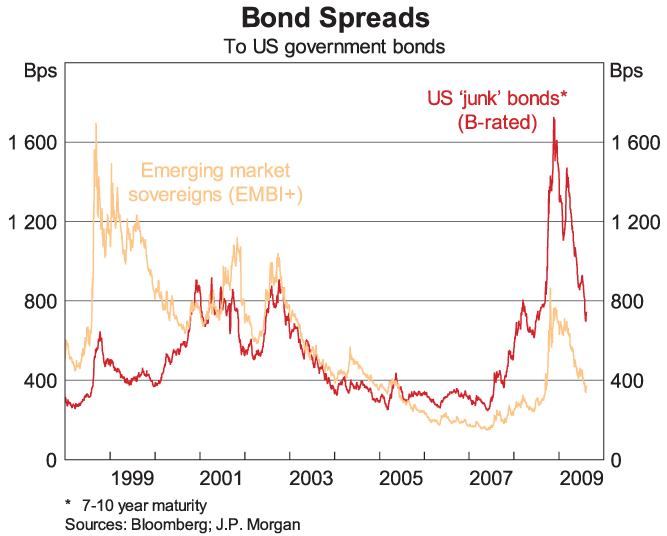
All of this was part of the much-publicised ‘search for yield’ in global investment markets. No doubt it was fuelled, in part, by perceptions that the risks associated with these instruments had genuinely declined. But there also seems to have been an increased investor appetite for risk, encouraged by the environment of low global interest rates. Subsequently, of course, these spreads blew out dramatically as the crisis unfolded although, as I'll come to in a moment, they have started to point to some improvement in confidence again over the past few months.
The same general pattern can be seen in interbank money market spreads. These had compressed to levels not much above zero in the major markets by early 2007. But in the crisis period they widened to unusually high levels, as both the perception of risk, and the desire to avoid risk, increased. I should add that, for the period of most extreme stress, these indicative spreads are in any case rather academic, since the interbank markets in the major economies were largely closed during this period, as were markets for longer-term bank funding. (It's interesting to note here that the markets generally took a more favourable view of Australian banks than those of other countries, another point that I'll come back to later.)
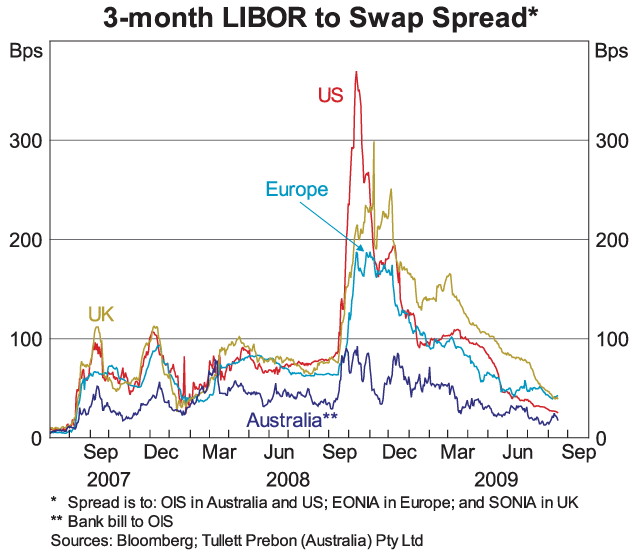
The immediate trigger for the most intense phase of the crisis was the series of failures, or near-failures, of major world financial institutions that occurred in September last year, centred on the collapse of Lehman Brothers. The peaks in credit spreads in most markets occurred shortly after the Lehman failure, but they remained at exceptionally high levels for some months afterwards.
These developments in credit markets brought on a wider collapse in confidence not just in financial systems but in the business and household sectors of the major economies. In the six months post-Lehman, equity prices in the major economies fell to levels between 30 and 50 per cent lower than they had been at the start of 2008. Indicators of business and consumer confidence also fell sharply, and spending and production levels contracted.
It was during this period that governments around the world stepped up their efforts to support their financial systems, by taking a number of extraordinary measures to provide guarantees for deposits and wholesale funding. The Irish government was the first to act in this way, in late September 2008, when it provided a guarantee with an unlimited cap for deposits in large institutions. This was an approach also followed by Austria and Denmark. In a number of other countries, including the US, the UK and a number of other European countries, existing caps on deposit protection were significantly increased. Around the same time, many governments moved to offer guarantees for wholesale funding, subject to various guarantee fees. Australia took these steps at around the same time as other countries, in October last year, with the arrangements becoming fully operational in late November.
We can see the effects of these developments on the ability of Australian banks to access term funding in wholesale markets. In the months immediately following the Lehman collapse, these markets were effectively closed, not just to Australian banks but to the global banking system in general. Issuance of term debt by Australian banks fell from an average of $12 billion a month, in the first half of the year, to virtually nothing by November. But with the availability of the guarantee from late 2008, banks were again able to raise term funding in substantial volumes, both domestically and offshore. In the early months of the scheme, guaranteed issuance was particularly strong, as banks accelerated their funding plans and sought to lengthen the maturity structure of their liabilities. The guarantee ensured that Australian banks were able to maintain access to capital markets, and as a result, the availability of funding has not generally been a constraint on their ability to lend during the crisis period.
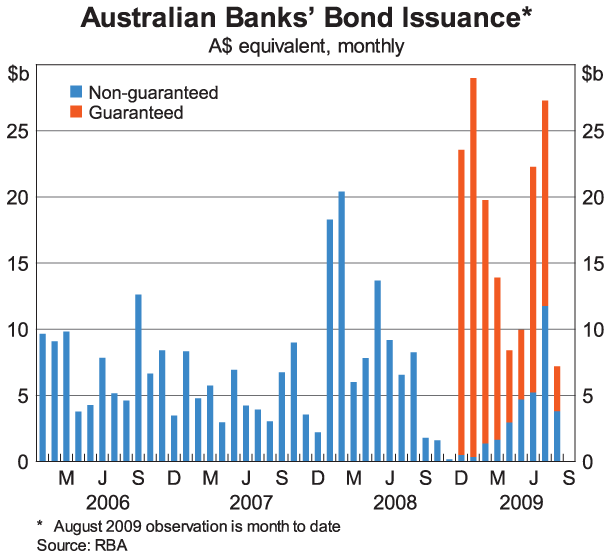
Overall, the various guarantee arrangements that were put in place around the world played an important part in stabilising conditions after the extreme dislocation that broke out last September. It should be remembered, though, that these were emergency arrangements, and designed to be temporary. Most countries have set expiry dates for their schemes, most commonly later this year for the wholesale component.
The pricing structure of the guarantees should also be thought of as an important part of the exit mechanism, since the guarantees are generally priced at levels that will become unattractive to borrowers as market conditions normalise. In this regard, it's encouraging to note that Australian banks have again begun to issue significant amounts of unguaranteed debt in the last month or so.
I said earlier that the most intense phase of the global crisis was in the six-month period from September to March. There have been a number of more positive signs in the period since then. Equity markets have regained quite a bit of lost ground, with the major markets up by between 40 and 50 per cent from their troughs in March. Related to that, there has been a significant rebound in indicators of business and consumer confidence. And credit spreads and risk premia in a range of global markets have been narrowing, though they are not yet back to normal.
In making these observations, I have to give the usual caution that the situation is still very uncertain, and further setbacks are still possible. But without making predictions, it's reasonable to say there are encouraging signs now that confidence is improving.
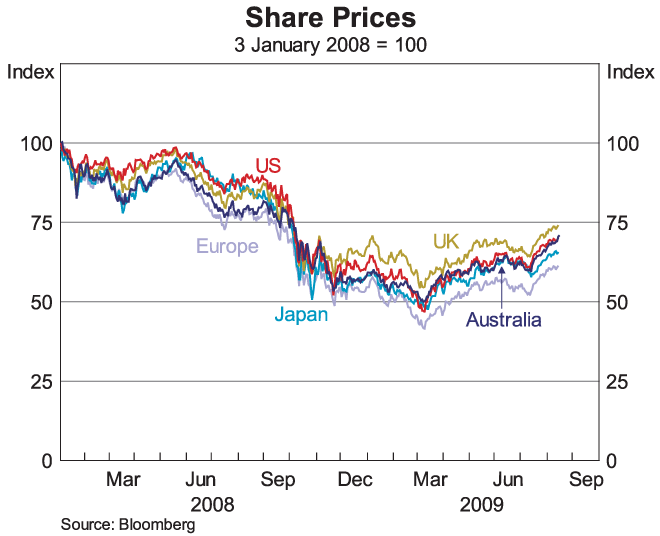
Resilience of the Australian Banks
I want to turn now to my second theme, which is the performance of the Australian banks. Throughout the crisis period, the Australian banking system has proven to be much more resilient than its counterparts abroad.
One obvious point of comparison is bank profitability. This is not always a popular point to make, but it's a great advantage during an economic downturn to have a banking system that remains profitable and is able to continue lending. In 2008 the major banks in the US and Europe moved sharply into loss, though some have returned to profit this year.

Australian banks, in contrast, have so far experienced only a small decline in their aggregate profitability, and they continue to earn a high rate of return on shareholders' equity overall.
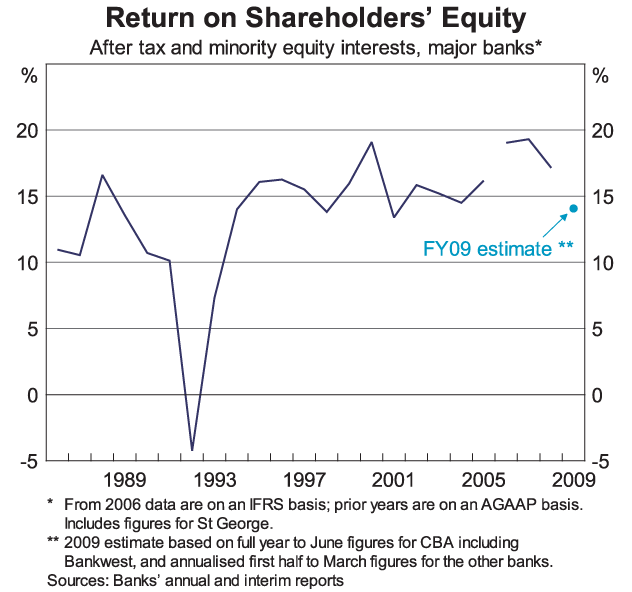
What explains this greater resilience?
One important point is that it's closely tied up with the relative performance of the economy itself: in other words, the strength of the banking and financial system has been both a contributor to, and a consequence of, Australia's relatively good economic performance. So one reason why banks have experienced relatively small asset losses is that the economic downturn in Australia has been nowhere near as severe as elsewhere.
But even allowing for that, it seems clear that Australian banks generally had stronger balance sheets coming into the crisis period, and less exposure to high-risk assets, than many of their international counterparts.
This has been particularly evident in banks' lending for housing. Although there has been some pick-up in housing loan arrears for Australian banks, the overall impairment rate remains very low. It currently stands at just over 0.6 per cent. This is likely to rise further in the current environment, but it is well below comparable figures in many other countries. In the United States, for example, the legacy of high-risk lending has contributed to a build-up in non-performing housing loans from less than one per cent of the banks' loan book to 5 per cent. In the UK the figure is around 2 per cent.
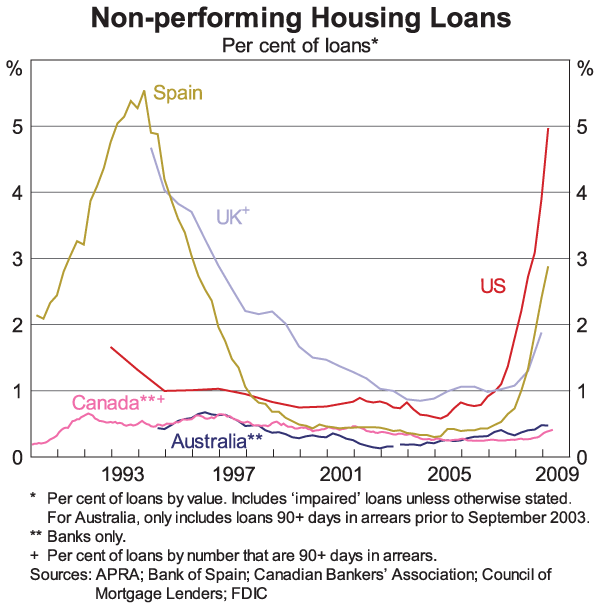
There are a number of reasons for the relatively favourable position of Australian banks on this front. Structural features of the Australian housing market have probably helped to make both borrowers and lenders more conservative than they are in some other countries. Unlike in parts of the United States, for example, housing loans in Australia are full-recourse, both in law and in practice, so borrowers have a stronger incentive to avoid over-committing themselves as well as to avoid default. In addition, the Uniform Consumer Credit Code puts some responsibility on the lender to avoid putting borrowers in a position of over-commitment. A further point is that the prudential regulator took steps in recent years to increase capital requirements on riskier types of mortgages.
It's hard to be definitive about the relative contributions of these factors. What does seem clear, though, is that the combination of legal, regulatory and structural characteristics of the Australian mortgage sector made it much more conservative in its behaviour than some of its overseas counterparts. Low-doc and non-conforming loans, for example, were always a very small part of the market in Australia, particularly in comparison with sub-prime mortgages in the US.
Another important factor has been the timing of the Australian housing cycle. Australia experienced its last major housing boom in the 2002–2003 period. For a number of years after that, the market went through a period of correction, when house prices were mostly either falling or were rising more slowly than incomes. This was also a period when construction of new housing was fairly subdued. Hence, the twin problems of over-priced housing and overbuilding that occurred in the United States in the run-up to the crisis were avoided in Australia.
A further point here is that, as well as having smaller loss rates than in some other countries, housing lending in Australia forms a relatively big part of banks' overall loan portfolio. Currently housing loans account for around 60 per cent of Australian banks' on-balance-sheet loans, compared to figures of around 35 per cent in the United States and the UK.
This is not to deny that there has been some decline in the overall asset quality of Australian banks. Impairment and loss rates have increased noticeably for business loans, particularly to the commercial property sector. Nonetheless, banks' overall stock of non-performing assets remains quite low, at around 1½ per cent of total assets. The Australian banking system is well capitalised, and many of the banks have strengthened their capital positions with new raisings over the past year. Among the top one hundred international banks, Australia's four majors remain part of only a very small group to be rated AA or higher.

The main way that Australian banks and other deposit-takers have been affected by the international crisis has been on the funding side. I talked earlier about the disruptions that occurred in wholesale credit markets. One important consequence of that has been an increase in banks' wholesale funding costs relative to the cash rate. Heightened competition for deposits has also added to relative funding costs.
There were also some significant flows in deposit markets reflecting the extreme risk aversion that took hold during much of 2008. The accompanying rather complicated graph shows the shares of the Australian deposit market accounted for by the different institutional groups. The four major banks gained market share during the year, with much of that change occurring prior to the announcement of the guarantee, as depositors engaged in a shift to perceived safety. The regional banks also gained market share. Most of the gains by Australian banks were at the expense of branches and subsidiaries of foreign banks. Credit unions and building societies lost some market share in the period up to September, but this stabilised after the announcement of the guarantee.
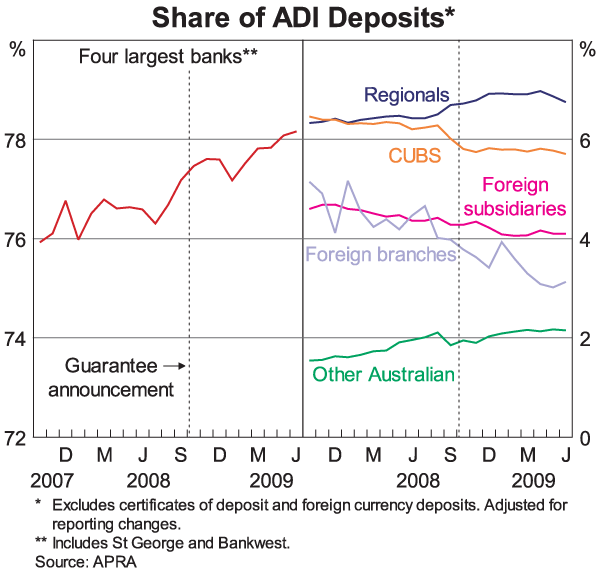
There has been some interest in how the guarantee itself might have affected these market shares. If we look at the absolute levels of deposits as in the next chart, it makes it clear that, proportionately, the regional and other smaller Australian banks experienced the largest growth in deposits in the period after the guarantee was announced.
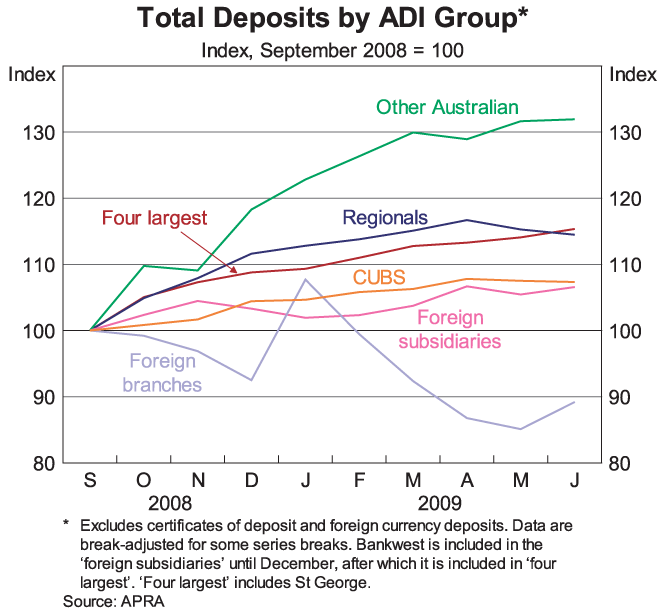
The disruptions to funding markets during the crisis period have also had an effect on lending patterns. One example of that has been in housing lending, where the effective closure of securitisation markets has had a pronounced effect on market shares. Wholesale lenders, and the smaller banks that rely significantly on securitisation markets to fund their lending, have lost market share during the crisis period. To a lesser extent, so have the credit unions and building societies, while the major banks made substantial gains. But to put this in perspective, this has followed a lengthy period when the major banks were losing market share, and the recent movements can be expected to start unwinding as securitisation markets recover.
In any case, these developments do not seem to have resulted in any shortage of housing finance in aggregate. Over the past six months, loan approvals for housing have increased by more than 20 per cent, in an environment where the market for established houses has been strengthening.
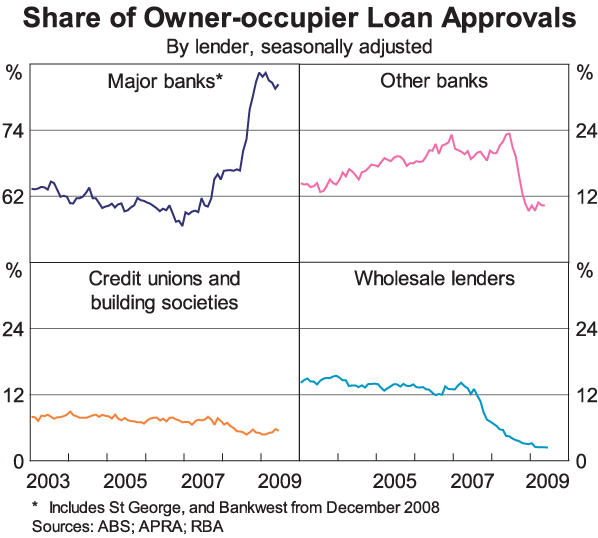
The Regulatory Environment
Let me say a few words about the regulatory environment before closing.
I've made the point that financial cycles are not new. They have been around for as long as financial activity itself, and they have centred around a wide variety of different assets, whether they be railway shares, commercial property, tech stocks or sub-prime mortgages. The one thing we can be sure of is that the next bubble will be different from the last one.
Financial regulation can't hope to eliminate this behaviour entirely, but the effort has to be made to contain system-wide risks within reasonable bounds. Governments and regulators around the world are doing a lot of work to draw lessons from the crisis so as to ensure the system is more robust in the future. Australia is participating in the discussions on these issues in various groups including the G-20, the Financial Stability Board and the Basel Committee on Banking Supervision.
Many of the details are still being worked out. Nonetheless, it's fairly clear where the main thrust of these global deliberations is heading. We are moving into a world where banks are going to be required to hold more capital and to take less risk. Regulators will be asking for higher liquidity resources. And they will be paying greater attention to the way risks interact across the financial system, in addition to the conventional focus on the safety of individual institutions.
In all of this there is a balance to be struck. More demanding regulation of banks' capital, liquidity and risk-taking will make the core of the system safer, but it will also add to banks' cost of doing business, and to the incentive to shift business into the less regulated parts of the system. It will be important to get this balance right.
Conclusion
Let me conclude by briefly re-iterating my main messages.
In the last year we have seen, globally, the biggest financial disruption in more than a generation.
By far the most intense phase of the crisis occurred during roughly the six-month period following the Lehman collapse in September last year.
Conditions now are still very challenging, and I'm wary of making any predictions. But in the past few months there have been encouraging signs of improvement.
And Australian banks to date have come through all of this in better shape than most.